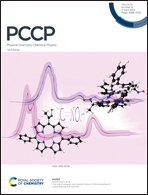Binding of berberine derivates to G-quadruplex: insight from a computational study†
Abstract
Human telomerase exhibits significant activity in cancer cells relative to normal cells, which contributes to the immortal proliferation of cancer cells. To counter this, the stabilization of G-quadruplexes formed in the guanine-rich sequence of the cancer cell chromosome has emerged as a promising avenue for anti-cancer therapy. Berberine (BER), an alkaloid that is derived from traditional Chinese medicines, has shown potential for stabilizing G-quadruplexes. To investigate the atomic interactions between G-quadruplexes and BER and its derivatives, molecular dynamics simulations were conducted. Modeling the interactions between G-quadruplexes and ligands accurately is challenging due to the strong negative charge of nucleic acids. Thus, various force fields and charge models for the G-quadruplex and ligands were tested to obtain precise simulation results. The binding energies were calculated by a combination of molecular mechanics/generalized Born surface area and interaction entropy methods, and the calculated results correlated well with experimental results. B-factor and hydrogen bond analyses demonstrated that the G-quadruplex was more stable in the presence of ligands than in the absence of ligands. Calculation of the binding free energy showed that the BER derivatives bind to a G-quadruplex with higher affinity than that of BER. The breakdown of the binding free energy to per-nucleotide energies suggested that the first G-tetrad played a primary role in binding. Additionally, energy and geometric properties analyses indicated that van der Waals interactions were the most favorable interactions between the derivatives and the G-quadruplexes. Overall, these findings provide crucial atomic-level insights into the binding of G-quadruplexes and their inhibitors.



 Please wait while we load your content...
Please wait while we load your content...